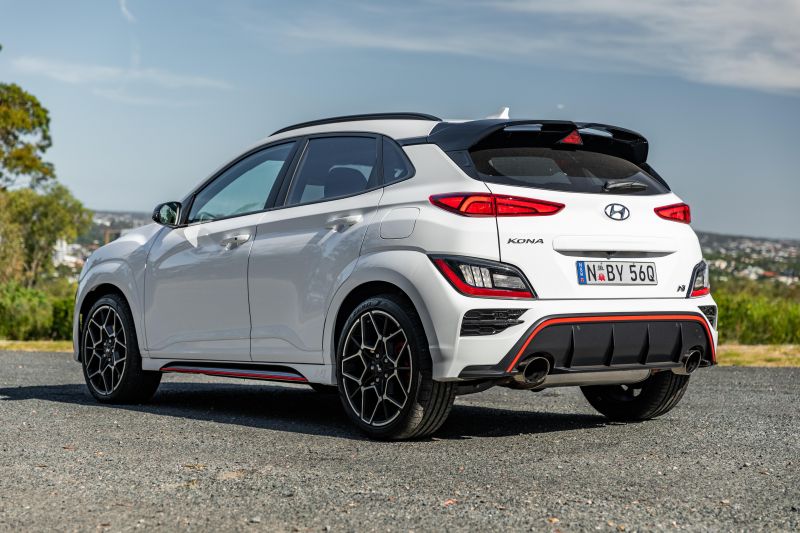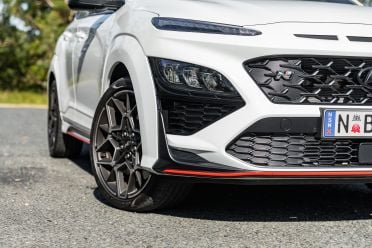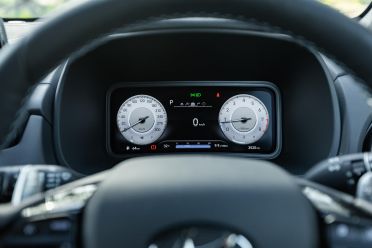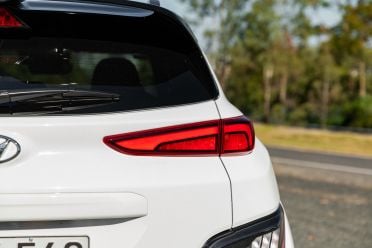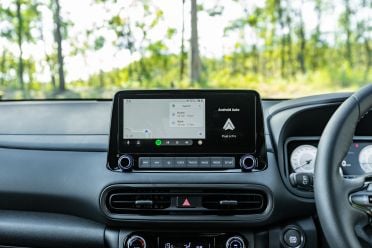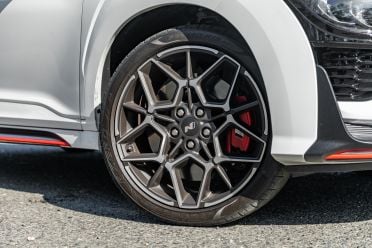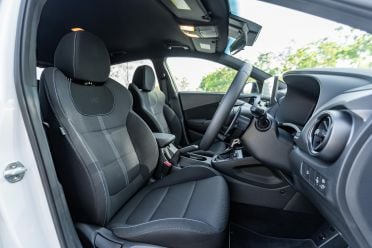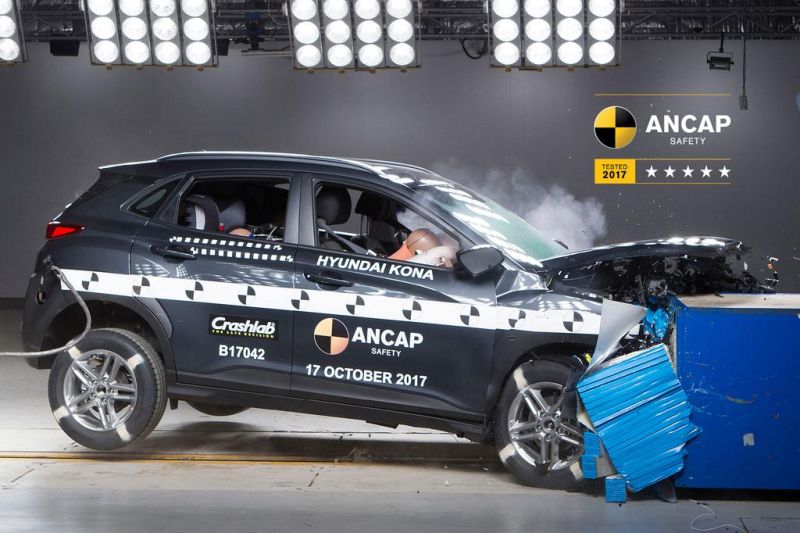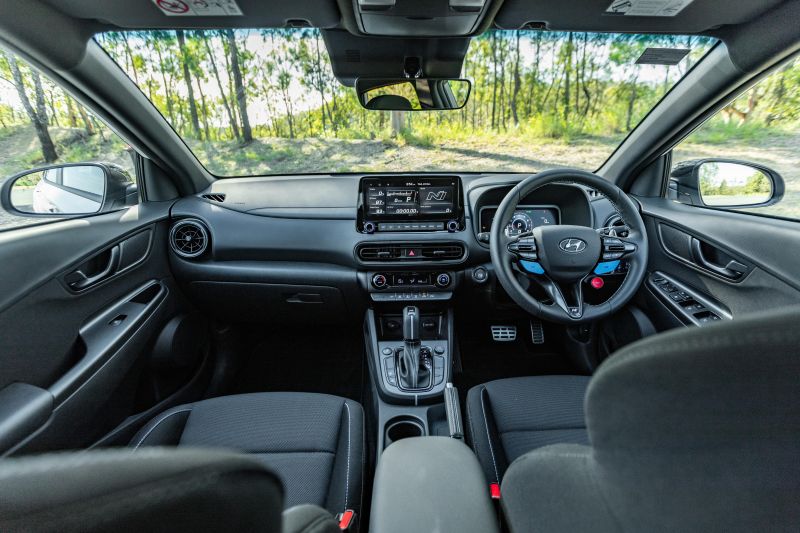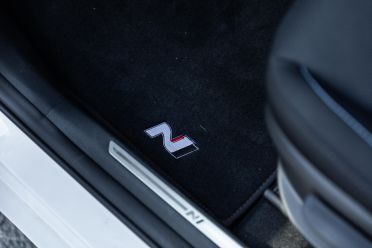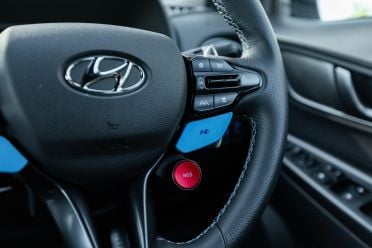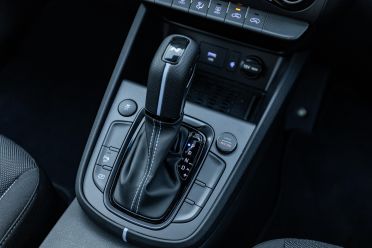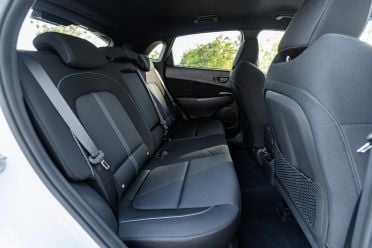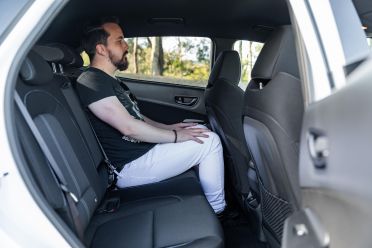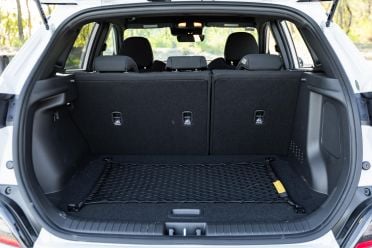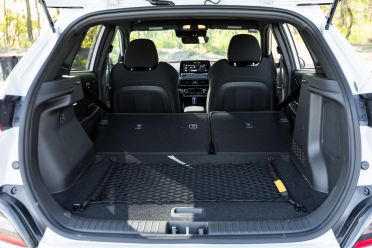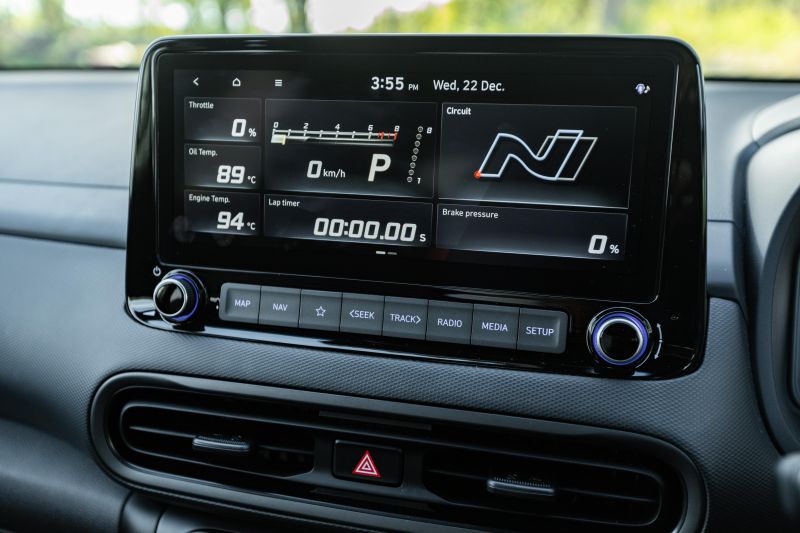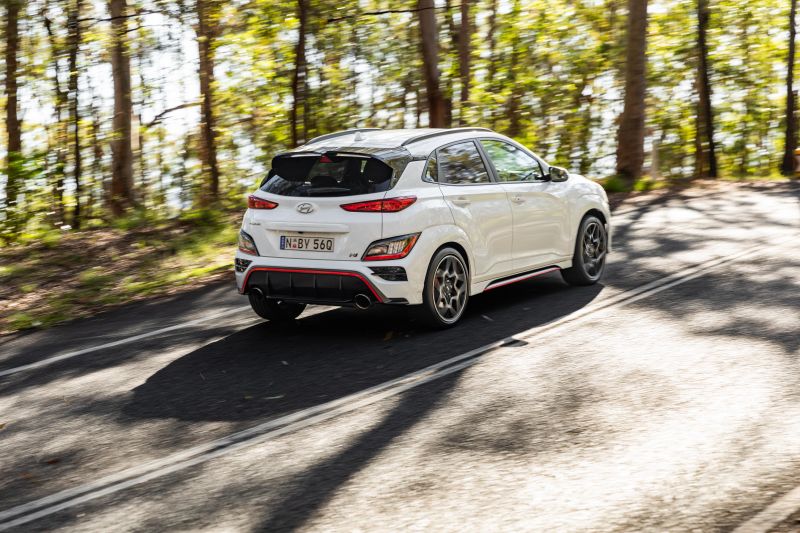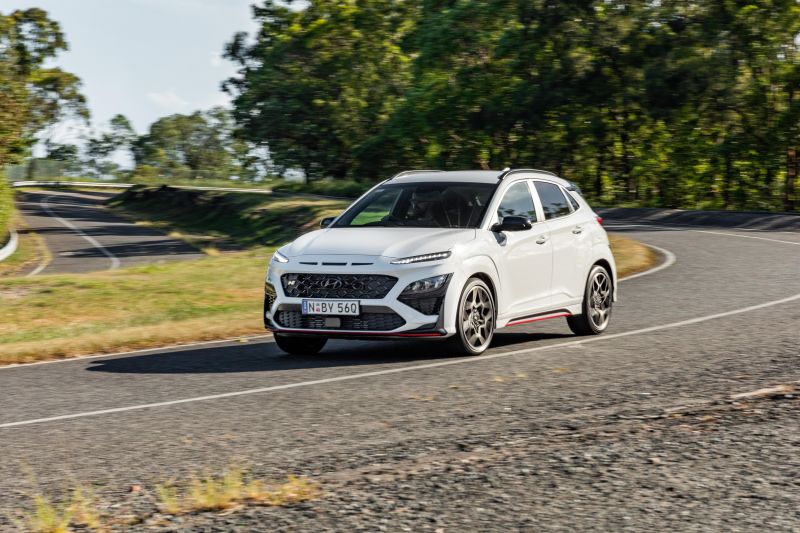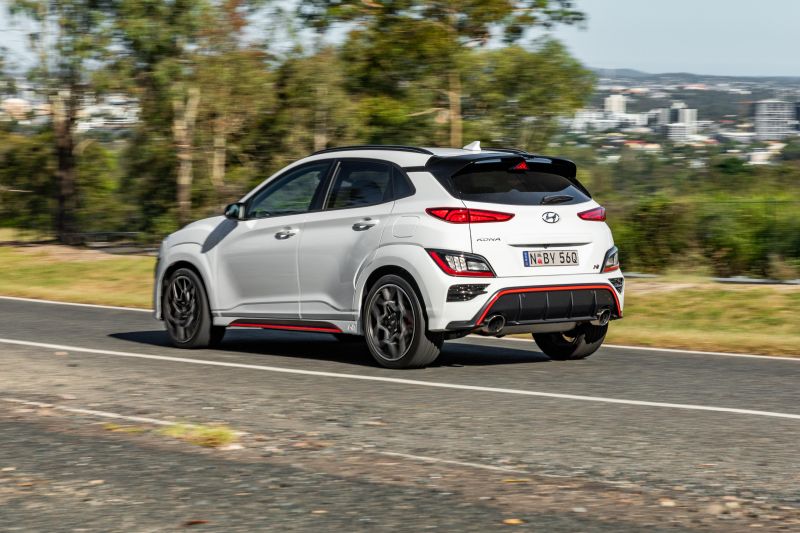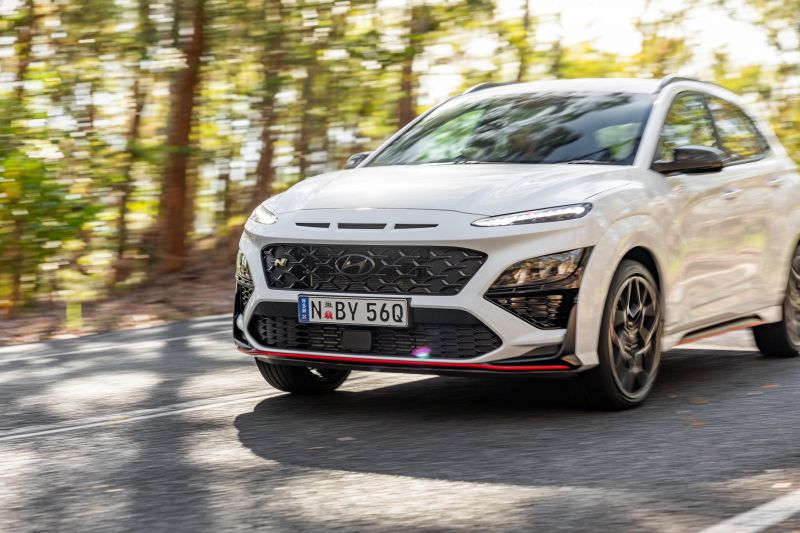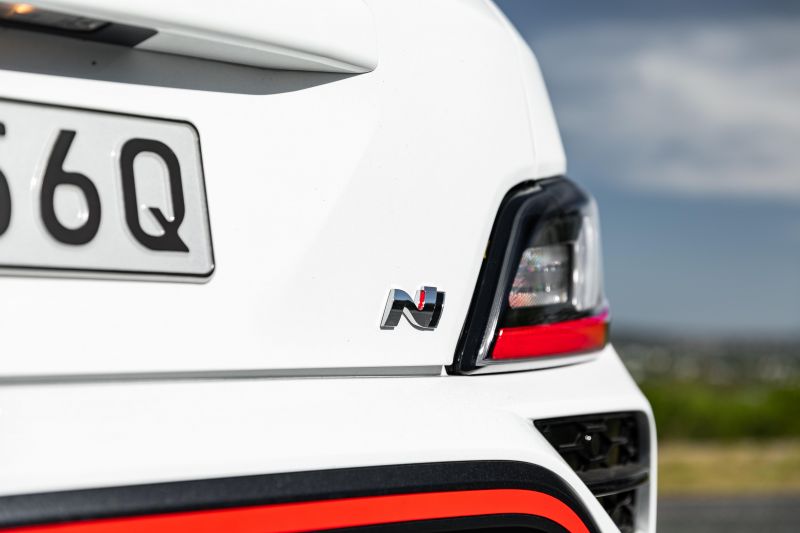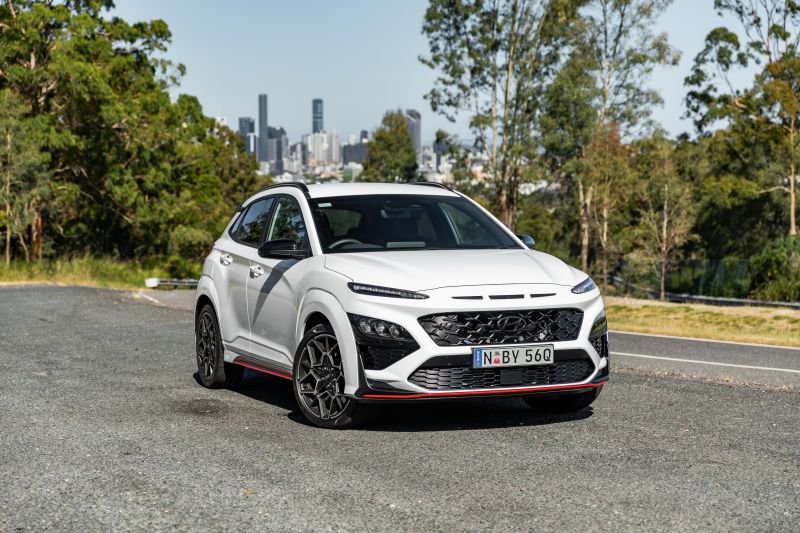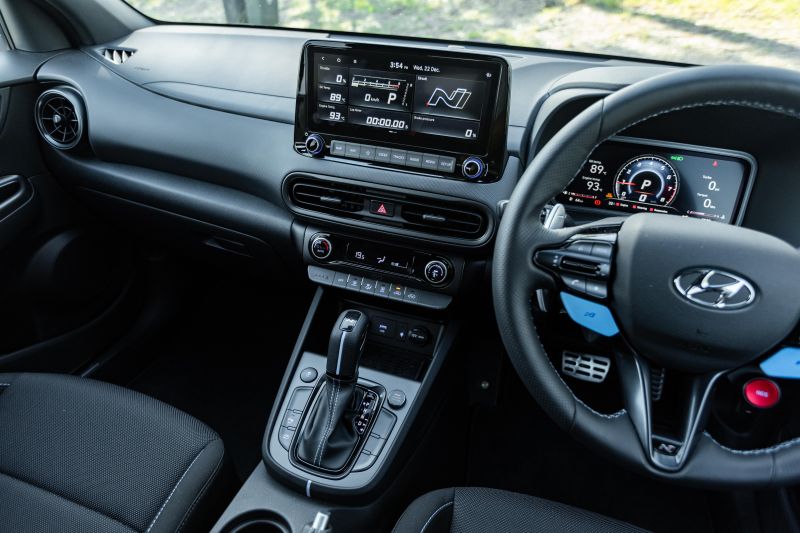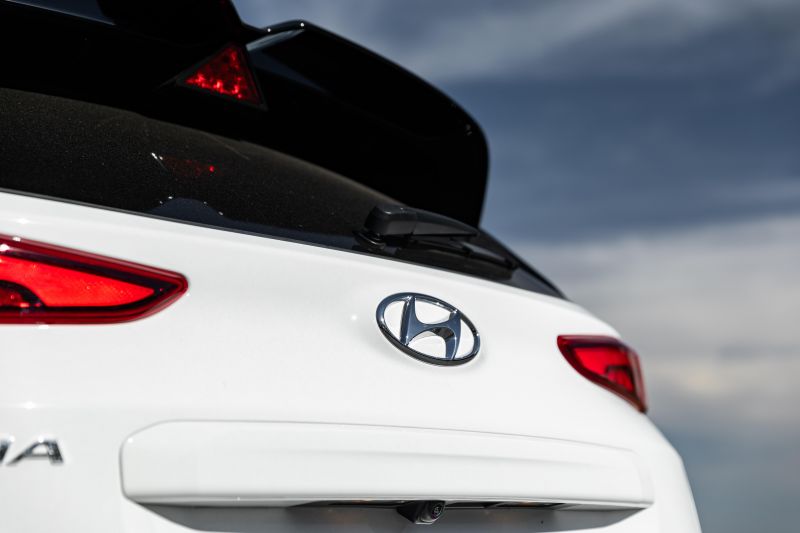Never underestimate the ability of Hyundai’s N division to make something truly special out of a humble mainstream vehicle.
That’s something the i20 N and i30 N have taught us, and we’ve put the Hyundai Kona N to the test to see if that can be proven positive here, too.
After all, this is the N division’s first SUV. Not that the Kona N follows the traditional formula of a performance SUV, mind you.
Like the Kona it’s based on, it’s actually less roomy than the passenger car it’s related to. It also doesn’t have all-wheel drive, something we’re used to seeing on performance SUVs from the Volkswagen Tiguan R all the way up to the Lamborghini Urus.
No all-paw traction and no extra cabin space puts the Kona N on the back foot already, while from experience the warm Kona N Line is disappointing. But instilling us with confidence is the knowledge the N team generally knows what they’re doing.
Let’s see if that applies to what Hyundai is calling its “first-ever True Hot SUV”.

How much does the Hyundai Kona N cost?
Surprisingly, the Kona N is priced identically to an i30 N with the same eight-speed dual-clutch automatic. Both ring up at $48,000 before on-road costs, though the i30 N with its standard six-speed manual starts at $45,000 before on-roads.
The Kona N Premium is priced from $51,000 list. Neither trim level is available with a manual.
Based on a Sydney postcode, you’re looking at $52,521 drive-away for a Kona N, or $55,671 drive-away for a Kona N Premium.
Atlas White, Ignite Flame and Performance Blue are the standard solid finishes, though you can pay $595 extra to get Cyber Grey metallic or Dark Knight or Phantom Black mica finishes. Gravity Gold matte is a $1000 option.
As a performance-focused small SUV from a mainstream brand, there’s not much in the way of competition for the Kona N. The Volkswagen T-Roc R arrives in August priced at $59,300 before on-road costs, while the larger Cupra Ateca VZx and Formentor VZx are pricier still at $60,990 and $61,490 before on-roads, respectively.
The less powerful, front-wheel drive Formentor VZ is a bit closer to Kona N territory, at $53,790 before on-roads ($58,490 drive-away).
What do you get?
If you were shocked by the complete absence of an “SUV tax”, be prepared for more surprises in the Kona N’s feature list when you compare it against that of an i30 N hatch.
For starters, it has adaptive cruise control, a feature unavailable in any other Hyundai N model thus far.
There’s also a 10.25-inch digital instrument cluster and rain-sensing wipers, the latter available only on the i30 N Premium. You only get single- instead of dual-zone climate control, however.
Kona N highlights:
- 19-inch alloy wheels
- Pirelli P Zero HN tyres
- Leather-wrapped steering wheel
- Sports front bucket seats
- 10.25-inch digital instrument cluster
- 10.25-inch infotainment system
- Wired Apple CarPlay and Android Auto
- Satellite navigation
- DAB+ digital radio
- Eight-speaker sound system
- Wireless phone charging
- Power-folding exterior mirrors
- Rain-sensing wipers
- Rear privacy glass
- Tyre pressure monitoring
- Keyless entry and start
Kona N Premium adds:
- Auto-dimming rear-view mirror
- Head-up display
- Front parking sensors
- Suede/leather interior trim
- Powered, heated and ventilated front seats
- Heated steering wheel
- Glass sunroof
- Ambient lighting
Is the Hyundai Kona N safe?
The wider Hyundai Kona range has a five-star rating from ANCAP, based on testing conducted in 2017, though the Kona N hasn’t been tested individually.
That rating was based on a frontal offset score of 14.07 out of 16 and a side impact score of 16 out of 16. Whiplash and pedestrian protection were rated Good and Acceptable, respectively.
Standard safety equipment includes:
- AEB with pedestrian/cyclist detection
- Adaptive cruise control
- Blind-spot assist
- Rear cross-traffic assist
- Auto high-beam
- Lane-keep assist
- Lane Follow Assist
- Safe Exit Warning
What is the Hyundai Kona N like on the inside?
The Kona N’s interior is little changed from lesser Kona models, at least at first glance.
For example, the digital instrument cluster features the same graphics as that found in up-spec members of the core Kona range.
Press one of the Performance Blue N buttons on the steering wheel, however, and you’ll see a burst of digitised flames as a unique instrument cluster view appears.
You’ll find Performance Blue highlights throughout the interior, including on the shifter. The seats also use the N division’s signature colour for their accent stitching, as does the chunky, leather-wrapped steering wheel.
There’s hardly a plethora of soft-touch surfaces, with a hard dashboard relieved only by a strip of soft-touch material across its front. Likewise, the hard plastic doors are broken up only by a leatherette insert. However, everything feels solid and well-screwed together.
The front seats are nicely bolstered, though we wouldn’t say they offer sublime comfort or chic upholstery. They do the job, though.
There’s no wireless Android Auto or Apple CarPlay, but there’s wired smartphone mirroring for the slick 10.25-inch infotainment system.
In addition to the logical interface, neat graphics and quick response times of the regular Kona’s system, the N includes unique N menus that allow you to easily view and configure drive settings on the fly.
There’s a bank of hard shortcut buttons beneath the touchscreen. While there’s no home button, you can program the star button accordingly.
The rear of the cabin is adequate. There’s enough room for somebody around 180cm tall to sit behind a similarly tall driver, but it never feels like there’s an abundance of space.
There’s little in the way of amenities, either – no rear air vents, and only a single USB-A outlet plus bottle holders in the doors that’ll fit some 1L bottles.
Compared to the i30 Hatch, there’s less headroom (down 16mm) and less shoulder room (down 21mm).
The cargo space measures just 361L, or 1143L with the rear seats dropped. Those figures are 72L and 250L less than the related Kia Seltos, with the Kona’s sloping, hatchback-like tailgate robbing it of versatility.
There’s even less cargo space than the i30 Hatch N, which boasts 381L and 1287L.
You can fit one large suitcase and one standard carry-on in the boot, but that’s about it. Under the boot floor, there’s a space-saver spare.
What’s under the bonnet?
The Kona N is powered by a 2.0-litre turbocharged four-cylinder engine producing 206kW of power between 5500 and 6000rpm and 392Nm of torque between 2100 and 4700rpm, mated to Hyundai’s new eight-speed wet dual-clutch automatic transmission.
There’s an electronically-controlled mechanical limited-slip differential on the front axle to help get the power down, which offers both Normal and Sport settings.
The Kona N’s outputs are identical to those of the i30 N and, like that model, the Kona N is front-wheel drive. Don’t let the SUV marketing fool you: there’s no all-paw traction here.
Sticking to front-wheel drive has allowed Hyundai to keep the weight down, with a kerb weight of 1569kg at its heaviest. However, that’s still 65kg heavier than an all-wheel drive N Line, which itself is 121kg heavier than a front-wheel drive ‘regular’ Kona.
Hyundai claims a 0-100km/h time of 5.5 seconds, just 0.1 seconds slower than a i30 Hatch N with DCT.
The Volkswagen T-Roc R also runs a turbocharged 2.0-litre four-cylinder engine, albeit with slightly more power and torque (221kW/400Nm). It’s also all-wheel drive and does the 0-100km/h dash in a claimed 4.9 seconds.
The Cupra Formentor VZx pumps out 228kW and 400Nm, but its more affordable, front-wheel drive VZ sibling produces 180kW and 370Nm. The Kona N therefore slots neatly in between the two, but undercuts them both on price.
How does the Hyundai Kona N drive?
Driving a Kona N back-to-back with an i30 N might expose a difference in feel, but in isolation the Kona N feels more hot hatch than mere souped-up Kona.
Indeed, there’s little in the way of an SUV feel here, beyond a slightly higher hip point. You won’t think you’re capable of tackling trails in this, and as well you shouldn’t, given it’s front-wheel drive and rolls on performance tyres.
Quickly turn a corner from a stop, or take off on a straight with launch control on, and you’ll both feel and hear the Kona N’s front end battling with the powerful turbocharged engine in the form of wheel hop.
Despite this, the Kona N manages to avoid feeling squirrelly in other driving situations, even when you’re driving with a heavy right foot.
Handling is nicely poised, and the Kona N tempts you to go hunting for corners. You will feel more body roll than an i30 N in tight corners, but the Kona N has a nice, hunkered down feel belying its SUV positioning.
The turbocharged four-cylinder engine was already worthy of praise, and it’s paired wonderfully with Hyundai’s new eight-speed dual-clutch auto.
Shifts are well-calibrated and rapid, and we rarely saw the need to use the paddle shifters. This is a vastly better unit than the dry-type seven-speed in the N Line.
There’s no dual-clutch hesitation at low speeds, nor is there any turbo lag, and the Kona N feels extremely responsive.
There’s a fantastic level of adjustability with the Kona N. The N menu on the touchscreen allows you to customise two additional drive modes beyond Normal, Comfort and Eco, which can be accessed by pressing either of the large N buttons on the steering wheel.
You can alter the parameters of the engine, steering, suspension, transmission, electronic limited-slip differential and stability control, and you can also activate launch control.
An additional N screen gives you readouts for brake pressure, oil and engine temperature and a lap timer, among other items. Kudos to Hyundai for making this easily accessible via the touchscreen instead of buried away in instrument cluster menus.
N Grin Shift is a harmless, if pointless, gimmick. Press the red steering wheel button labelled NGS and throttle response and gear shifts are quickened for 20 seconds, with a countdown timer appearing in the instrument cluster.
Regardless of which of the three suspension settings you choose, the Kona N rides firmly though it never feels crashy on even some of the craggiest of Brisbane’s roads.
There isn’t a wide gulf between any of the suspension settings in terms of ride comfort, though I found myself programming my custom N mode to have Sport or Sport+ toggled for each of the adjustable parameters bar suspension, which I left in Normal.
Exhaust sound I left in Sport+ because, so programmed, the Kona N sounds fantastic. It gives the exhaust a bassier sound plus crackles and pops with downshifts, which enhances the car’s soundtrack.
Besides the sound of the turbocharger spooling up, the Kona N in normal mode sounds rather too much like other four-cylinder engines in Hyundai’s range, with a coarse engine note. The variable exhaust helps conceal that engine sound.
As for the steering, it’s quite weighty in every setting but the middle Sport setting for it strikes a good balance – it’s not so heavy that tight parking lot manoeuvres are cumbersome, while there’s a satisfying amount of both weight and road feel when you’re out on the open road.
As with the regular Kona, there’s a bit too much outside noise venturing inside. That includes wind noise at highway speeds and some tyre roar on the highway and over coarse-chip roads.
We greatly appreciate the presence of adaptive cruise control, something missing from the i30 N. There’s also Hyundai’s Lane Following Assist, which works with the adaptive cruise control to keep you centred in your lane and a safe distance from other vehicles – however, Hyundai’s calibration of this for the Kona range doesn’t seem as adept as with its other models.
How much does the Hyundai Kona N cost to run?
The Kona N, like the rest of the Hyundai range, is covered by a five-year, unlimited-kilometre warranty.
Servicing is required every 12 months or 10,000km, whichever comes first, and the first five services are capped at $335 each. That’s identical to the i30 N.
Over our loop, comprising a mix of inner-city, suburban and highway driving, I averaged 9.8L/100km. This increased to 10.9L/100km during my time with the car, which saw me driving it for 963km. Mind you, I didn’t baby the car and it was in one of the N custom modes for much of that distance.
The claimed combined cycle fuel economy rating for the Kona N is 9.0L/100km.
CarExpert’s Take on the Hyundai Kona N
On the surface, the Hyundai Kona N seems to be a bit of a waterproof tea bag. It either seems like the answer to a question nobody’s asking, or at the very least a strange left-field answer.
After all, it’s an SUV based on a hatchback albeit with less cargo and cabin space, while there’s no extra off-road ability and not even the option of all-wheel drive.
But despite its SUV positioning, the Kona N is priced identically to a comparable i30 N yet includes more standard equipment. Its styling is arguably a bit funkier than the i30 N hatchback, too, while you get the higher hip point that comes with a crossover.
Back-to-back on a track, the Kona N is unlikely to be quite as fun as an i30 N. But it’s a lot more fun than almost everything in its class, while it undercuts the likes of the Volkswagen T-Roc R by thousands of dollars.
So long as you’re aware this is an SUV designed for hauling ass and not hauling large adults and lots of suitcases, you’ll probably enjoy owning a Kona N.
It’s all a bit pointless, but in an utterly enjoyable way.
Click the images for the full gallery
MORE: Everything Hyundai Kona





